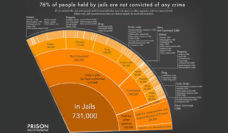How do the nearly 2 million people imprisoned in the United States receive health care? Inmates are typically transferred to community hospitals when prison hospitals do not have the necessary equipment or capacity. In these hospitals, prisoners—the only U.S. residents with a protected right to health care–are often treated in chains.
Lawrence Haber and colleagues examined the practice of inpatient shackling from a medical and legal standpoint, how cuffs introduce both physical and psychological harms to the patient.
Shackles are typically used whenever an incarcerated person is taken outside of prison confines and are meant to prevent escape or prisoners harming others. In 2017, the 9th U.S. Circuit Court of Appeals ruled that shackling criminal defendants in the courtroom violates their due process clause. Yet no national policies or ethics codes prohibit shackling in hospital settings.
Corrections officers escort incarcerated patients to hospitals, and the officer typically has control of how and when shackles are used. Routine shackling in hospitals has created a treatment norm that hospital staff do not often question. In a primary referral hospital for a county jail in Utah, Katherine C. Brooks found that only 37% of physicians and 33% of nurses requested that shackles be removed when obtaining a patient history or during a physical exam.
While there is a federal ban on shackling incarcerated pregnant patients, many states have still not abolished the practice. Patients who are unconscious, in surgery, or in end-of-life stages may also remain in chains when flight risk and the potential to cause harm are non-existent.
Incarceration is proven to have detrimental effects on physical and mental health, and unnecessary shackling creates another barrier between incarcerated persons and adequate or sympathetic care.
Amar Bansal and Lawrence Haber illustrate the bias shackles can create through an anecdote about an unconscious man on a ventilator in shackles with a declining prognosis. When asked why shackles were necessary, the attending physician said it was protocol and then referred to rumors about prisoners faking illness to escape. Bansal and Haber conclude “the prejudgment precipitated by the shackle preceded any facts about the person or the situation at hand.”
Kevin Pierre and colleagues explored physician attitudes toward incarcerated patients. They found 9.3% of physicians surveyed strongly agreed or agreed they had a negative attitude toward their incarcerated patients, which climbed to 24.5% if the physician knew the patient had committed a “violent” crime.
While safety measures are essential in protecting hospital staff, over 50% of incarcerated persons are being held for non-violent offenses. And the label “violent crime” is widely used, even to describe offenses that do not involve physical harm. For example, some states classify methamphetamine manufacturing or entering a dwelling that is not your own as “violent” crimes even if no person was physically harmed. Default shackling policies may also pay little consideration to how much time the patient has already served or their current behavior.
Hospitals are permitted to establish their own policies regarding the treatment of incarcerated patients instead of deferring to prison policy. Incarceration is proven to have detrimental effects on physical and mental health, and unnecessary shackling creates another barrier between incarcerated persons and adequate or sympathetic care.
Photo via Getty Images














